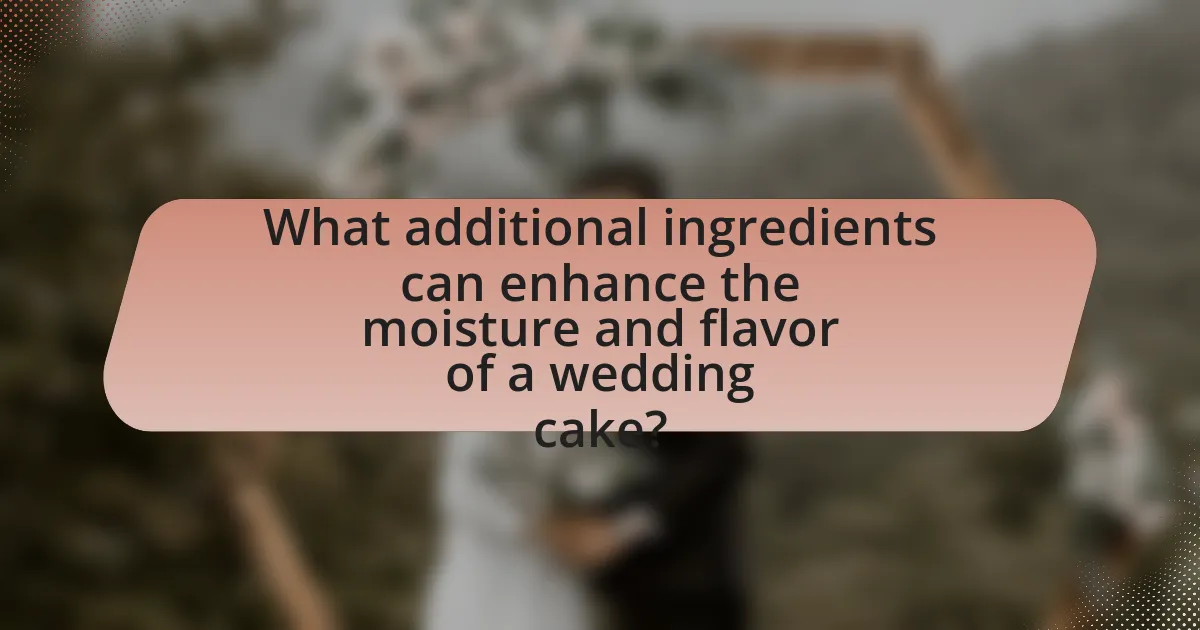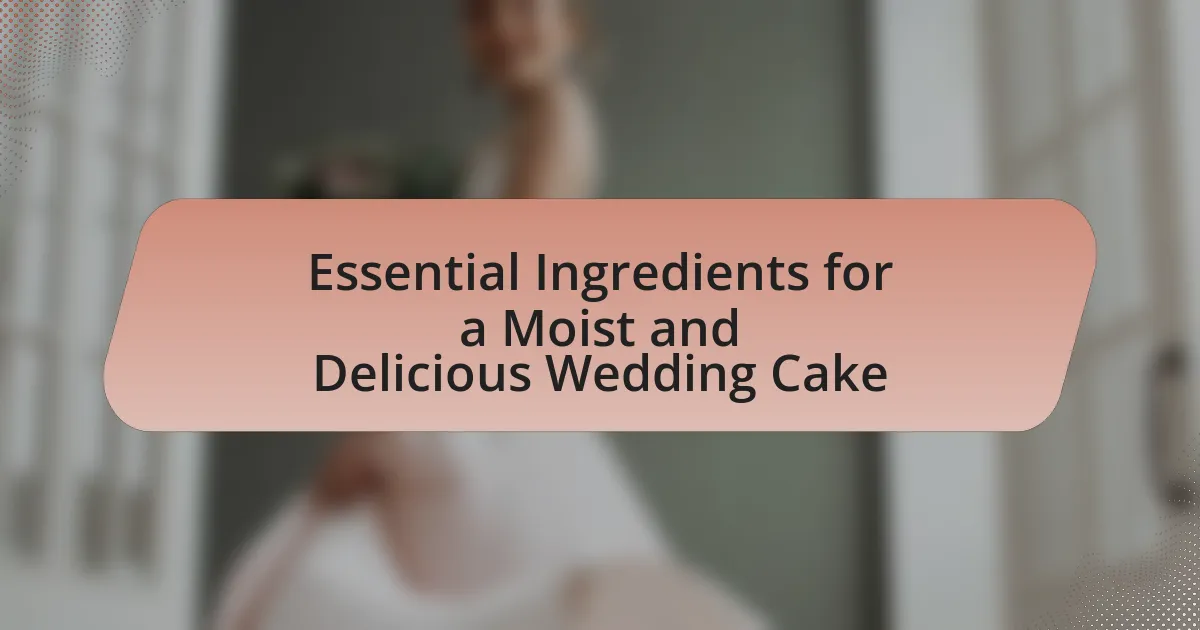The article focuses on the essential ingredients required for creating a moist and delicious wedding cake, emphasizing the importance of high-quality flour, sugar, eggs, butter, baking powder, milk, and flavorings. It discusses how moisture affects the cake’s texture and flavor, detailing factors that contribute to moisture levels, such as the type of liquid ingredients, fat content, and mixing methods. The article also explores the roles of different flours, sweeteners, fats, and dairy products in enhancing moisture and flavor, along with tips for achieving the perfect cake and common baking mistakes to avoid. Overall, it provides a comprehensive guide for anyone looking to bake a memorable wedding cake.

What are the Essential Ingredients for a Moist and Delicious Wedding Cake?
The essential ingredients for a moist and delicious wedding cake include high-quality flour, sugar, eggs, butter, baking powder, milk, and flavorings such as vanilla or almond extract. High-quality flour provides the necessary structure, while sugar contributes to moisture and sweetness. Eggs add richness and stability, and butter enhances flavor and texture. Baking powder acts as a leavening agent, ensuring the cake rises properly. Milk adds moisture, and flavorings elevate the overall taste profile. These ingredients, when combined in the right proportions, create a cake that is both moist and flavorful, essential for a memorable wedding celebration.
Why is moisture important in a wedding cake?
Moisture is crucial in a wedding cake because it directly affects the cake’s texture, flavor, and overall enjoyment. A well-moistened cake ensures a tender crumb, preventing it from becoming dry and crumbly, which can detract from the eating experience. Additionally, moisture enhances the cake’s flavor by allowing the ingredients to meld together, resulting in a richer taste. Studies in baking science indicate that cakes with optimal moisture levels retain freshness longer and maintain their appealing qualities during events, making them more enjoyable for guests.
What factors contribute to a cake’s moisture level?
The factors that contribute to a cake’s moisture level include the type and amount of liquid ingredients, the fat content, the sugar content, and the mixing method. Liquid ingredients such as milk, water, or eggs provide hydration, while fats like butter or oil help retain moisture. Sugar not only sweetens but also attracts moisture, enhancing the cake’s overall texture. Additionally, the mixing method affects how air is incorporated, influencing the cake’s density and moisture retention. For instance, creaming butter and sugar together introduces air, leading to a lighter cake that can hold moisture better.
How does the choice of ingredients affect moisture?
The choice of ingredients significantly affects moisture in a wedding cake. Ingredients such as fats, sugars, and liquids contribute to the cake’s overall moisture content; for instance, butter and oil provide richness and moisture retention, while sugars attract and hold water. Additionally, the use of eggs adds moisture and structure, as they contain both liquid and emulsifiers that help bind ingredients together. Research indicates that cakes made with higher fat content tend to have a more tender crumb and retain moisture better than those with lower fat levels. Therefore, selecting the right combination of these ingredients is crucial for achieving a moist and delicious wedding cake.
What types of flour are best for wedding cakes?
The best types of flour for wedding cakes are cake flour and all-purpose flour. Cake flour, which has a lower protein content (around 7-9%), produces a tender and light texture ideal for delicate cakes. All-purpose flour, with a protein content of about 10-12%, can also be used, providing a slightly denser cake while still maintaining moisture. Both flours contribute to the overall structure and crumb of the cake, ensuring it holds up well during stacking and decoration.
How does cake flour differ from all-purpose flour?
Cake flour differs from all-purpose flour primarily in its protein content and texture. Cake flour has a lower protein content, typically around 7-9%, compared to all-purpose flour, which ranges from 10-12%. This lower protein level results in a finer texture and a lighter, softer crumb in baked goods, making it ideal for cakes. The specific milling process of cake flour also contributes to its delicate structure, allowing for better absorption of liquids and fats, which enhances moisture retention in cakes.
What role does gluten play in cake texture?
Gluten plays a crucial role in determining cake texture by providing structure and elasticity. When flour is mixed with liquid, gluten proteins (gliadin and glutenin) combine to form a network that traps air and moisture, contributing to the cake’s rise and overall stability. This gluten network is essential for achieving the desired crumb structure; a well-developed gluten structure results in a light and airy texture, while insufficient gluten can lead to a dense and heavy cake. Studies show that cakes made with higher gluten content, such as those using bread flour, tend to have a chewier texture, whereas cakes made with lower gluten flours, like cake flour, yield a tender and soft crumb.
What sweeteners can enhance the flavor and moisture of a wedding cake?
Natural sweeteners such as honey, agave nectar, and maple syrup can enhance the flavor and moisture of a wedding cake. Honey adds a distinct floral sweetness and retains moisture due to its hygroscopic properties, which help keep the cake moist over time. Agave nectar is sweeter than sugar and has a lower glycemic index, contributing to a moist texture while imparting a mild flavor. Maple syrup not only provides a unique taste but also adds moisture, making it an excellent choice for enhancing both flavor and texture in cakes. These sweeteners are often used in cake recipes to achieve a balance of sweetness and moisture, ensuring a delicious final product.
How do different sugars impact the cake’s texture?
Different sugars significantly impact a cake’s texture by influencing moisture retention, aeration, and overall structure. Granulated sugar, for instance, creates a light and airy texture due to its ability to incorporate air during the creaming process, which helps in leavening. Brown sugar, containing molasses, adds moisture and results in a denser, chewier texture, while powdered sugar, with its fine granules, can create a smoother batter that leads to a tender crumb. The varying moisture content and granule size of these sugars directly affect how the cake rises and its final mouthfeel, as supported by baking science that emphasizes the role of sugar in the Maillard reaction and caramelization, both of which contribute to texture and flavor development.
What are the benefits of using liquid sweeteners?
Liquid sweeteners provide enhanced moisture and improved texture in baked goods, making them ideal for wedding cakes. Their high water content helps retain moisture during baking, resulting in a softer crumb. Additionally, liquid sweeteners like honey and agave syrup can enhance flavor complexity and contribute to a more balanced sweetness compared to granulated sugars. Studies show that cakes made with liquid sweeteners often have a more tender texture and can remain fresh longer due to their hygroscopic properties, which attract and hold moisture.

How do fats contribute to a moist wedding cake?
Fats contribute to a moist wedding cake by providing richness and tenderness to the cake’s texture. When fats, such as butter or oil, are creamed with sugar, they create air pockets that help to leaven the cake, resulting in a lighter structure. Additionally, fats coat the flour proteins, which reduces gluten formation and leads to a softer crumb. Research indicates that cakes made with higher fat content retain moisture better than those with lower fat levels, as fats help to trap and hold water within the cake matrix. This moisture retention is crucial for achieving the desired moistness in wedding cakes, ensuring they remain fresh and enjoyable for longer periods.
What types of fats are commonly used in wedding cakes?
Commonly used fats in wedding cakes include butter, margarine, and vegetable oils. Butter is favored for its rich flavor and ability to create a tender crumb, while margarine offers a similar texture at a lower cost. Vegetable oils, such as canola or sunflower oil, are often used for their moisture-retaining properties and neutral taste. These fats contribute to the overall texture and flavor profile of the cake, ensuring it remains moist and delicious.
How does butter compare to oil in terms of moisture retention?
Butter retains moisture better than oil due to its water content and emulsifying properties. Butter typically contains about 15-20% water, which contributes to moisture retention in baked goods, while oil is 100% fat and lacks this water component. The presence of water in butter helps create steam during baking, which can enhance the cake’s texture and moisture level. Additionally, the emulsifiers in butter help to trap air and moisture, further improving the overall moisture retention in cakes compared to oil.
What is the impact of using shortening or margarine?
Using shortening or margarine in baking significantly affects the texture and moisture of the final product. Shortening, which is 100% fat, creates a tender and flaky texture in baked goods, while margarine, which contains water and emulsifiers, can lead to a softer crumb but may also introduce a slight flavor difference. Research indicates that cakes made with shortening tend to have a higher volume and a lighter texture compared to those made with margarine, as shortening helps to trap air during the creaming process. Additionally, the fat content in shortening contributes to moisture retention, resulting in a longer-lasting freshness in cakes.
Why are eggs considered a crucial ingredient in cake recipes?
Eggs are considered a crucial ingredient in cake recipes because they provide structure, moisture, and richness to the cake. The proteins in eggs coagulate during baking, helping to stabilize the cake’s structure and prevent it from collapsing. Additionally, eggs contribute to the cake’s moisture content, which is essential for achieving a tender crumb. The emulsifying properties of egg yolks also help to blend fats and liquids, resulting in a uniform batter. This is supported by culinary science, which shows that cakes made without eggs often lack the desired texture and flavor, leading to denser and drier results.
What functions do eggs serve in cake baking?
Eggs serve multiple essential functions in cake baking, including providing structure, moisture, and leavening. The proteins in eggs coagulate during baking, which helps to stabilize the cake’s structure and maintain its shape. Additionally, eggs contribute to the cake’s moisture content, enhancing its texture and preventing it from becoming dry. The emulsifying properties of eggs also help to blend fats and liquids, resulting in a uniform batter. Furthermore, eggs can act as a leavening agent, as the air trapped in beaten eggs expands during baking, contributing to the cake’s rise. These functions are critical for achieving a moist and delicious wedding cake.
How can egg substitutes affect moisture and texture?
Egg substitutes can significantly affect the moisture and texture of baked goods, including wedding cakes. For instance, ingredients like applesauce or yogurt can enhance moisture retention due to their high water content, while flaxseed meal or chia seeds can create a gel-like consistency that mimics the binding properties of eggs. Research indicates that using these substitutes can lead to a denser texture, which may be desirable in certain cake recipes, but could also result in a less airy structure compared to traditional egg-based cakes. Studies have shown that cakes made with egg substitutes often require adjustments in baking time and temperature to achieve optimal results, confirming that the choice of substitute directly influences the final product’s moisture and texture.

What additional ingredients can enhance the moisture and flavor of a wedding cake?
To enhance the moisture and flavor of a wedding cake, ingredients such as buttermilk, sour cream, and fruit purees can be added. Buttermilk and sour cream introduce acidity, which tenderizes the cake and adds richness, while fruit purees like applesauce or mashed bananas contribute natural sweetness and moisture. Research indicates that incorporating these ingredients can significantly improve the texture and taste of baked goods, making them more appealing for special occasions like weddings.
How do dairy products contribute to cake moisture?
Dairy products contribute to cake moisture primarily through their fat and liquid content. Ingredients such as milk, cream, and yogurt add moisture to the batter, which helps create a tender crumb and prevents the cake from drying out during baking. For instance, whole milk contains about 87% water, which directly enhances the hydration of the cake mixture. Additionally, the fats in dairy products, like butter or cream, coat flour proteins, inhibiting gluten formation and resulting in a softer texture. This combination of moisture and fat is essential for achieving a moist and delicious cake, particularly in wedding cakes where texture is crucial for overall enjoyment.
What types of dairy are most effective for adding moisture?
Whole milk and buttermilk are the most effective types of dairy for adding moisture to baked goods, particularly wedding cakes. Whole milk contributes fat and liquid, enhancing the cake’s tenderness and moisture retention. Buttermilk, with its acidity, not only adds moisture but also reacts with baking soda or baking powder to create a lighter texture. Studies show that cakes made with buttermilk are often moister and have a finer crumb compared to those made with regular milk.
How does sour cream or yogurt influence cake texture?
Sour cream and yogurt enhance cake texture by adding moisture and creating a tender crumb. The acidity in these ingredients interacts with baking soda or baking powder, promoting leavening and resulting in a lighter cake. Additionally, the fat content in sour cream and yogurt contributes to a rich mouthfeel, which improves overall texture. Research indicates that cakes made with sour cream or yogurt often have a softer and more velvety texture compared to those made with only milk or water, making them ideal for moist and delicious wedding cakes.
What role do flavorings and extracts play in a wedding cake?
Flavorings and extracts are crucial in a wedding cake as they enhance the overall taste and aroma, making the cake more enjoyable for guests. These ingredients, such as vanilla extract, almond extract, or citrus zest, contribute distinct flavors that can complement the cake’s texture and sweetness. For instance, vanilla extract is commonly used to provide a rich, warm flavor that pairs well with various cake types, while almond extract adds a nutty depth. The use of flavorings can also evoke personal or cultural significance, allowing couples to incorporate their preferences into the cake.
How can the choice of flavoring affect the overall cake experience?
The choice of flavoring significantly impacts the overall cake experience by influencing taste, aroma, and texture. Different flavorings, such as vanilla, chocolate, or fruit extracts, create distinct sensory profiles that can enhance or detract from the enjoyment of the cake. For instance, vanilla is often associated with a classic, comforting taste, while chocolate can provide richness and depth. Additionally, flavorings can affect the cake’s moisture retention; for example, fruit purees can add both flavor and moisture, resulting in a more enjoyable texture. Studies have shown that flavor perception is closely linked to aroma, meaning that the chosen flavoring can also enhance the cake’s olfactory appeal, further enriching the overall experience.
What are some popular flavor combinations for wedding cakes?
Popular flavor combinations for wedding cakes include vanilla and almond, chocolate and raspberry, lemon and blueberry, and red velvet with cream cheese frosting. These combinations are favored for their complementary tastes and textures, enhancing the overall experience of the cake. For instance, vanilla and almond create a rich, aromatic base, while chocolate and raspberry offer a delightful contrast of sweetness and tartness. Lemon and blueberry provide a refreshing, fruity option, and red velvet paired with cream cheese frosting delivers a classic, indulgent flavor profile. These combinations are widely recognized in the wedding industry for their appeal and ability to satisfy diverse palates.
What are some tips for achieving the perfect moist wedding cake?
To achieve the perfect moist wedding cake, use high-quality ingredients and incorporate moisture-retaining techniques. Start with a balanced recipe that includes fat, such as butter or oil, which contributes to moisture. Additionally, consider adding ingredients like sour cream, yogurt, or buttermilk, as they enhance moisture content and flavor.
Incorporating simple syrup, a mixture of sugar and water, can also help keep the cake moist after baking. Baking at the correct temperature and avoiding overmixing the batter are crucial, as overmixing can lead to a dry texture. Finally, ensure the cake is stored properly, wrapped tightly to prevent air exposure, which can dry it out. These methods are supported by baking science, which emphasizes the importance of moisture retention for achieving a tender cake.
How can baking techniques influence moisture retention?
Baking techniques significantly influence moisture retention in baked goods. Techniques such as proper mixing, temperature control, and the use of specific ingredients can enhance moisture retention. For instance, creaming butter and sugar incorporates air, which helps create a lighter texture that can hold moisture better. Additionally, baking at the correct temperature ensures that the outer layer of the cake sets quickly, trapping moisture inside. Research indicates that cakes baked at lower temperatures tend to retain more moisture compared to those baked at higher temperatures, as the latter can lead to excessive evaporation. Furthermore, incorporating ingredients like sour cream or yogurt can add moisture due to their high water content, contributing to a tender crumb.
What are common mistakes to avoid when baking a wedding cake?
Common mistakes to avoid when baking a wedding cake include not properly measuring ingredients, which can lead to imbalanced flavors and textures. Accurate measurements are crucial; for example, using a kitchen scale ensures precision, as even slight variations can affect the cake’s rise and moisture. Another mistake is underbaking or overbaking the cake, which can result in a dry or overly dense texture. Monitoring baking times and using a toothpick test can help achieve the right doneness. Additionally, neglecting to allow the cake layers to cool completely before frosting can cause the icing to melt and slide off, compromising the cake’s appearance. Proper cooling is essential for maintaining structural integrity. Lastly, not testing recipes in advance can lead to unexpected results on the wedding day; conducting a trial bake allows for adjustments and ensures the final product meets expectations.
